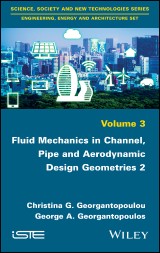Details

Fluid Mechanics in Channel, Pipe and Aerodynamic Design Geometries 2
1. Aufl.
|
139,99 € |
|
| Verlag: | Wiley |
| Format: | |
| Veröffentl.: | 16.04.2018 |
| ISBN/EAN: | 9781119522386 |
| Sprache: | englisch |
| Anzahl Seiten: | 304 |
DRM-geschütztes eBook, Sie benötigen z.B. Adobe Digital Editions und eine Adobe ID zum Lesen.
Beschreibungen
<p>Fluid mechanics is an important scientific field with various industrial applications for flows or energy consumption and efficiency issues. This book has as main aim to be a textbook of applied knowledge in real fluids as well as to the Hydraulic systems components and operation, with emphasis to the industrial or real life problems for piping and aerodynamic design geometries. Various problems will be presented and analyzed through this book.</p> <p> </p>
<p>Preface ix</p> <p><b>Chapter 1. Pipe Networks 1</b></p> <p>1.1. Introduction 1</p> <p>1.2. Calculation of pipe networks 3</p> <p>1.3. Problem-solving methodology for pipe networks 10</p> <p>1.4. Overall approach for the network calculation 12</p> <p>1.5. The Hazen–Williams equation for network analysis 13</p> <p>1.6. Hazen–Williams and Darcy–Weisbach identity 15</p> <p>1.7. Hardy–Cross method 18</p> <p>1.8. Formulae 21</p> <p>1.9. Questions 23</p> <p>1.10. Problems with solutions 23</p> <p>1.11. Problems to be solved 53</p> <p><b>Chapter 2. Open Channel Flow 57</b></p> <p>2.1. Introduction 57</p> <p>2.2. Non-dimensional parameters in open channels 58</p> <p>2.3. Open channel types of flow 59</p> <p>2.4. Open channels’ geometrical shapes 61</p> <p>2.4.1. Channels of rectangular cross-sectional area 61</p> <p>2.4.2. Channels of trapezoidal cross-sectional area 62</p> <p>2.4.3. Channels of circular cross-sectional area 63</p> <p>2.5. The hydraulic jump 65</p> <p>2.6. Calculation of the depth flow after the hydraulic jump 65</p> <p>2.7. Velocity distribution 68</p> <p>2.8. Velocity distribution at the vertical level 68</p> <p>2.9. Uniform flow in open channel equations – Chezy type 70</p> <p>2.10. Best hydraulic cross-sectional area 75</p> <p>2.11. Specific flow energy 79</p> <p>2.12. Channels of rectangular cross-sectional area 80</p> <p>2.13. Open channels’ more adequate cross-sectional areas 83</p> <p>2.13.1. Rectangular cross-sectional area 83</p> <p>2.13.2. Trapezoidal cross-sectional area 85</p> <p>2.14. Non-uniform flow in open channels 88</p> <p>2.15. Channels of non-rectangular cross-section area 90</p> <p>2.16. Formulae 92</p> <p>2.16.1. Channels of rectangular cross-sectional area formulae 93</p> <p>2.16.2. Channels of trapezoidal cross-section formulae 93</p> <p>2.16.3. Channels of circular cross-sectional area formulae 94</p> <p>2.16.4. Channels of rectangular cross-sectional area formulae 99</p> <p>2.16.5. Channels of non-rectangular cross-sectional area formulae 100</p> <p>2.17. Questions 101</p> <p>2.18. Problems with solutions 103</p> <p>2.19. Problems to be solved 116</p> <p><b>Chapter 3. Boundary Layer 119</b></p> <p>3.1. Introduction 119</p> <p>3.2. Laminar incompressible boundary layer 120</p> <p>3.3. Characteristic values of the boundary layer 125</p> <p>3.3.1. Thickness δ of the boundary layer 125</p> <p>3.3.2. The thickness displacement 1 δ<sub>1</sub>’.126</p> <p>3.4. Flow types in the boundary layer 127</p> <p>3.5. Formulae 131</p> <p>3.6. Questions 133</p> <p>3.7. Problems with solutions 133</p> <p>3.8. Problems to be solved 145</p> <p><b>Chapter 4. Flow Around Solid Bodies 147</b></p> <p>4.1. Introduction 147</p> <p>4.2. Geometrical characteristics of an airfoil 148δ</p> <p>4.3. Kutta–Joukowski equation 150</p> <p>4.4. Aerodynamic paradox 152</p> <p>4.5. Pressure distribution in an airfoil 153</p> <p>4.6. Lift curve 156</p> <p>4.7. Drag force and drag coefficient curve 158</p> <p>4.7.1. Drag of skin friction 158</p> <p>4.7.2. Form drag 159</p> <p>4.7.3. Induced drag 161</p> <p>4.8. Parameters that influence the drag coefficient CD 163</p> <p>4.8.1. Dependence of CD on the body’s shape 163</p> <p>4.8.2. Dependence of CD on relative roughness 165</p> <p>4.8.3. Dependence of CD on the Reynolds number 170</p> <p>4.9. External flow around industrial solid bodies 177</p> <p>4.9.1. Car’s motion 177</p> <p>4.9.2. Surface vessel’s motion 178</p> <p>4.9.3. Wind flow in ground constructions 179</p> <p>4.9.4. Airplane’s motion 181</p> <p>4.10. Drag in fluid drops and gas bubbles in creeping flow 190</p> <p>4.11. Formulae 191</p> <p>4.12. Questions 193</p> <p>4.13. Problems with solutions 196</p> <p>4.14. Problems to be solved 209</p> <p>Appendices 211</p> <p>Appendix 1. Symbols and Units 213</p> <p>Appendix 2. Tables and Diagrams of Natural Values 219</p> <p>Appendix 3. Symbols and Basic Conversion Factors 237</p> <p>Appendix 4. International Standard Atmosphere, SI Units 239</p> <p>Appendix 5. International Standard Atmosphere, in BS 251</p> <p>Appendix 6. NACA Airfoils’ Diagrams 259</p> <p>Bibliography 287</p> <p>Index 289</p> <p> </p>
<strong>Christina G. Georgantopoulou</strong>, Faculty Member in Fluid Mechanics, School of Engineering, Bahrain Polytechnic, Isa Town, Kingdom of Bahrain. <p><strong>George A. Georgantopoulos</strong>, Faculty Member in Fluid Mechanics, School of Engineering, Bahrain Polytechnic, Isa Town, Kingdom of Bahrain.
Diese Produkte könnten Sie auch interessieren:

Turbulent Drag Reduction by Surfactant Additives

von: Feng-Chen Li, Bo Yu, Jin-Jia Wei, Yasuo Kawaguchi

156,99 €

Turbulent Drag Reduction by Surfactant Additives

von: Feng-Chen Li, Bo Yu, Jin-Jia Wei, Yasuo Kawaguchi

156,99 €














